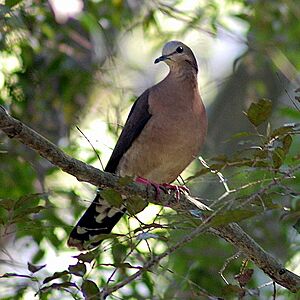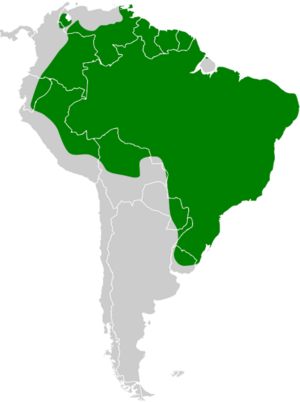Grey-fronted dove facts for kids
The grey-fronted dove (Leptotila rufaxilla) is a large, beautiful dove that lives in tropical areas of the New World. You can find it on the island of Trinidad and in almost every country in mainland South America, except for Chile.
Quick facts for kids Grey-fronted dove |
|
|---|---|
 |
|
| Conservation status | |
| Scientific classification | |
| Genus: |
Leptotila
|
| Species: |
rufaxilla
|
 |
|
Contents
About the Grey-Fronted Dove
The grey-fronted dove is a fascinating bird. Scientists group it with other doves like the grey-headed dove and the pallid dove. For a while, people thought these doves were all the same species. But now we know they are different, though they are still very closely related.
There are actually six slightly different types, or "subspecies," of the grey-fronted dove. Each subspecies has small differences, like their size or the exact shades of their feathers.
What the Grey-Fronted Dove Looks Like
This dove is about 28 centimeters (11 inches) long. It usually weighs between 115 and 183 grams (4 to 6.5 ounces).
Male grey-fronted doves have a grayish or bluish forehead. Their head is bluish-gray, and their neck has a pretty purplish shine. Their eyes are yellow or brown. Around their eyes, they have bare red skin, which is then surrounded by soft pinkish-white feathers. Their throat is also pinkish-white.
The upper part of their body is olive-brown. Their tail feathers are olive-brown in the middle. The outer tail feathers are blackish with clear white tips. Their chest is a lovely grayish-pink, fading to white on their belly. They have a black beak and red legs and feet.
Female doves are a bit browner than males. Their upper body might have a greenish tint. Young doves look similar to females. However, their chest has rust and brown bars, and their upper feathers have rusty edges.
Where Grey-Fronted Doves Live
The grey-fronted dove lives in South America. You can find them on the island of Trinidad. They also live east of the Andes mountains. Their home stretches from Colombia and Venezuela all the way south to Paraguay, Uruguay, and northeastern Argentina.
These doves prefer to live in humid forests. They are often found deep inside the forest. But you might also spot them at the edges or in clearings. In Colombia, they live in different types of forests, including those that flood and those on higher ground. They usually live below 550 meters (1,800 feet) in Venezuela. But in southeastern Brazil, they can be found as high as 2,200 meters (7,200 feet).
How Grey-Fronted Doves Live
What Grey-Fronted Doves Eat
Grey-fronted doves search for food on the forest floor. They eat seeds and small fruits like berries. They also enjoy insects, such as small butterflies and moths. Other tiny creatures without backbones are also part of their diet. Sometimes, they even eat bananas and rice if they find them at feeding spots.
Reproduction and Nests
Grey-fronted doves can breed almost all year long in Trinidad. In other places, their breeding season is shorter. They build a simple nest that looks like a platform. They make it from twigs in a bush, tree, or palm tree. The female dove usually lays one or two white eggs.
The Dove's Song
The song of the grey-fronted dove is quite unique. It's a single, sad, and steady note. It sounds like a soft "wooOOOoo" that slowly gets louder and then fades away.
Status of the Grey-Fronted Dove
The IUCN (International Union for Conservation of Nature) has looked at the grey-fronted dove. They say it is a species of "Least Concern." This means it is not currently in danger of disappearing. There are more than 500,000 of these doves. However, their numbers are thought to be slowly going down.


